#snakes and serpents can represent wisdom and knowledge
Explore tagged Tumblr posts
Text


The Caduceus: Hermes Symbol of Harmony and Awakening
Hermes and the Caduceus
The Caduceus is primarily associated with Hermes Trismegistus, the Greek god known for being a messenger, guide of souls, and protector of merchants, shepherds, gamblers, liars, and thieves.
The symbol consists of a short rod entwined by two serpents and topped with a pair of wings, embodying the diverse and dynamic attributes of Hermes.
According to myth, the Caduceus originated in a specific episode involving Hermes.
One day, while traveling, Hermes came across two serpents entangled in a violent conflict. The serpents, locked in battle, were a symbol of discord and chaos. Observing their strife, Hermes sought to bring peace between them.
With a simple, yet profound gesture, he threw his rod between them as a mediator would step into a conflict.
The serpents, rather than continuing their fight, wrapped themselves around the rod in a double helix formation and their fighting ceased.
This act not only separated them but transformed their aggression into a dynamic balance, creating a new symbol of harmony and equilibrium.
The wings at the top of the rod signify the divine nature of the intervention and the elevation of the solution from earthly disputes to heavenly peace.
This transformative moment in mythology conveys deep symbolic meanings.
The serpents, traditionally symbols of wisdom, renewal, and healing due to their ability to shed their skin and renew themselves, here represent the dual forces of nature and life.
Their harmonious entanglement around the rod, which itself symbolizes authority and control, visually captures the balance between these forces.
This depiction illustrates the principle that through wise intervention and diplomatic action, balance and harmony can be achieved, transforming destructive energy into a constructive outcome.
The Caduceus carries layers of symbolism that delve into the nature of duality, healing, and transformation.
The two serpents coiled around a central staff encapsulate a visual depiction of balance and union of opposites, a theme prevalent in many philosophical and spiritual teachings.
Integration of Opposing Forces
The dual serpents of the Caduceus, spiraling around the central staff, visually signify the integration of opposing forces, a concept pivotal in many philosophical systems.
This integration is not merely a passive coexistence but an active unification that leads to greater wholeness and stability.
In many cultures, serpents are seen as embodying opposites — being both earth-bound and capable of transcendental knowledge.
Their union around the staff symbolizes the potential for reconciling such differences to foster unity and peace.
Symbol of Mediation and Peace
Hermes, wielding the Caduceus, guides the chaotic forces represented by the serpents towards reconciliation and unity.
Thus, the Caduceus symbolizes the transformation of conflict into peace and order, embodying the potential for wise intervention to harmonize opposing forces.
This portrayal of Hermes as a divine mediator illustrates how the Caduceus serves as a powerful emblem of peace, skillfully bridging gaps and mending rifts, whether in mythological tales or spiritual symbolism.
Balance and Equilibrium
In a broader spiritual and psychological context, the Caduceus mirrors the internal journey towards achieving personal equilibrium.
The intertwining snakes can be interpreted as the balancing of various aspects of one’s nature — rational and emotional, physical and spiritual.
This balance is crucial for personal growth and health, reflecting the adage that true healing and well-being are holistic processes that reconcile and align different facets of the self.
Transformation and Renewal
Serpents are also symbols of transformation and renewal, widely recognized for their ability to shed their skin and emerge anew.
This aspect of the serpent imagery within the Caduceus resonates with the concept of healing and medicine, where recovery and renewal are central themes.
The cyclic renewal of serpents provides a powerful metaphor for the medical process itself — the shedding of ill health to reveal wellness, the transformation of disease into healing.
Ascension and Divine Connection
The wings atop the Caduceus elevate its symbolism from earthly to divine, representing ascension, spiritual awakening, and the connection between the earthly and celestial realms.
In mythology, Hermes uses his winged sandals and helmet to traverse freely between the divine and mortal worlds, and similarly, the wings on the Caduceus suggest a bridging of gaps — between health and sickness, earth and sky, human and divine.
This aspect emphasizes the spiritual dimension of healing, suggesting that health is not only a physical state but also involves spiritual well-being and alignment.
The Caduceus as a Medical Symbol
The Caduceus is widely recognized today as a symbol of medicine, particularly in the United States.
This association began in the late 19th and early 20th centuries when military medical organizations adopted the Caduceus as part of their insignia.
The choice was influenced by its mistaken confusion with the Rod of Asclepius, the traditional Greek symbol for healing and medicine, which features only one snake and no wings.
The Caduceus’s adoption in medicine was largely due to its decorative symmetry and historical prestige, not its original symbolic meanings.
Caduceus Symbol, Rod of Asclepius, Doctor Symbol Art
55 notes
·
View notes
Note
So in QSMP most of the eggs we seen them as dragon right? I was going to draw Chunsik but i couldn't find any good reference for him (try to look for korean dragon but i couldn't find any)
like im afraid if i draw the type of dragon wrong or something, do you think you can help?
Here's the article i found explaining the differences of korean dragon from other east asian dragon i'll put some of the text below :3
[...] Korean Dragons originally start out as gigantic land serpents, otherwise known as ‘Imugi’, who then transform into true dragons, or ‘Yong’. Such transformation only comes from time and patience (both noble virtues) as being the guardian of Korean culture.
Some of the most striking physical differences from western dragons are that Korean dragons do not have any wings and sport long beards -- attesting to their wisdom and knowledge. They also dawn a variety of colors - green, blue, gold, or red - and can sometimes be seen next to a river, mountain, waterfalls, or the sky. They typically take on a wavy or circular form, which represents the intricacy of life’s many obstacles and high points. Most importantly, these dragons are often depicted carrying an orb in their claws, or mouth, called a ‘yeouiju’ representing authority over creation and divine will. [...]
[...] The Korean dragon also displays nine different animal traits that represent a holistic symbol of the Asianic animal kingdom. It embodies luck by having a nose of a pig; the abundance of the rabbit by sharing its eyes; the giving nature of a cow by having its ears; the elegance of a deer's antlers as its horns; the sturdy forehead of the camel; the long and adapting body of the snake; fertility with the scale patterns of a carp; the long claws of a hawk; and the power of a tiger’s fists. These all-encompassing qualities are unique to the Korean dragon. [...]
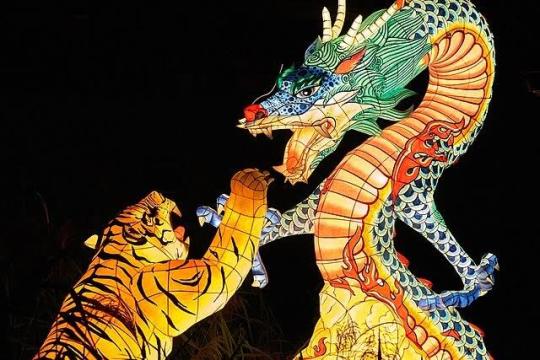

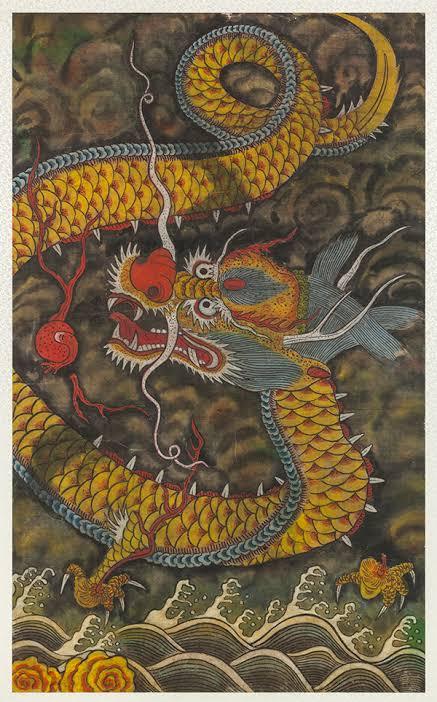
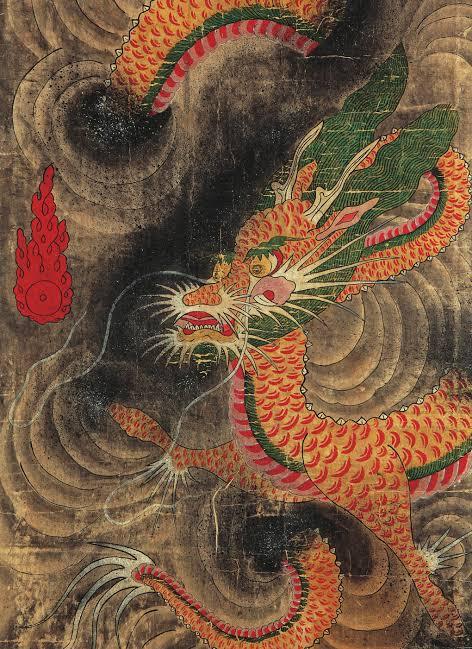

96 notes
·
View notes
Text

The Wise One Pen and ink on paper 29.7 x 42 cm
In my latest illustration, I explore the archetype of the wise old woman.
Folktale and myth origins
The wise old woman is a character that often appears in old fairy tales as a bestower of knowledge that will aid the hero in his journey. Alternatively, she can be a moral presence in the story that tests the hero through different challenges. The most well known examples of this archetype are Baba Yaga from Slavic folklore or the Crone aspect of Hecate, the Greek goddess of magic and witchcraft.
The water and moon symbolism
The old woman sits on a black vast ocean surrounded by galaxies denoting her timeless nature. She lives at the edge of consciousness, imparting her wisdom to the astral traveler - the dreamer.
From the Jungian point of view, she represents a spiritual function surfacing out of the subconscious. This function is the feminine instinctual nature of the psyche.
Both water and the Moon symbolize this instinctual, subconscious side of the Self. The Moon is also a storehouse of dreams, ancestry, and emotional ties from past lives that reflect themselves in our behaviors and patterns. This is where the old woman appears in initiatory dreams to signal to us that it is time to outgrow old stagnant structures, clean up our mental home, and revitalize our lives so that we welcome new energy in. The water here also represents this idea of purification of the Self.
The Serpent Symbol
The white serpent at her feet is another symbol of renewal and the life-death-rebirth cycle. The snake is a common symbol found in almost any culture. It’s interpreted either in its revelatory aspect - as a keeper of ancestral wisdom or as a symbol of death, darkness, and decay - the lowest point we reach before we begin a new cycle.
The significance of the old woman in dreams
The presence of an old woman in dreams can sometimes appear as a detached, cryptic or frightening presence to the dreamer. The more we suppress those negative aspects of ourselves or avoid facing destructive habits and patterns that keep us from growing, the more of a creepy old hag she appears to us.
The cross symbol
Lastly, i want to mention the North African Indigenous cultures that i used as reference when drawing her. The clothing and tattoos on her face and hands are inspired by the Amazigh, nomadic desert tribes living in Northwest Africa for more than 20,000 years. The symbol she holds in her hand is a Tuareg cross. Its main role is apotropaic, a talisman made of silver for protection against evil that is given to a person when they are traveling.
The wise old woman archetype embodies both light and darkness. She is that wild, healing side that we find in ourselves when we’re lost in darkness and suffering. She is always there waiting to impart her knowledge no matter how cruel it sounds because she can pierce through illusion. She is truth and discernment.
#dark artists#artists on tumblr#ink illustration#occult art#spiritual art#esoteric art#occultism#divine feminine#dream symbolism
19 notes
·
View notes
Text
Week 2: Goddess Sirona “She Who Makes Us Better"
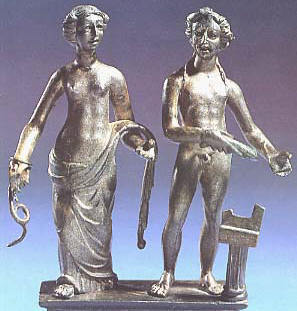
Sirona is a Gaulish/Celtic healing deity. Her cult predates the Romans, but all her iconography comes from the Romanization of Gaul, and her worship was widely spread all over Europe from Hungary to Brittany.
Many artifacts of her worship come from the Treveri in the Moselle Valley who venerated Sirona and built the rich healing shrine at Hochscheid. Shrines to Sirona have been found at Niedaltdorf, Bitburg, and Wiesbaden in Germany, and Metz, Luxeuil, and Corseul (Brittany) in France.

Her statues appear both alone and with Apollo Grannus or Apollo Borvo. The Romans interpreted Sirona as Hygeia, daughter of the healer-god Asclepius and granddaughter of Apollo, and her imagery indicates references to the chthonic mystery cults, including ears of corn, associated with Demeter and the Eleusinian Mysteries.
She is often shown with the snake and bowl of eggs, both symbols of regeneration and rebirth. The eggs represent the snake’s young, perhaps a fertility reference. While she normally wears a dress and sometimes even a veil, the bronze statue at Mâlain depicts Thiron(a) semi-nude with a serpent on her arm.
The context of her artifacts stress her role as one who heals through hot springs. Healing sanctuaries at springs drew large numbers of pilgrims who came there to spend the night. Hygeia/Salus protected against danger and cured mental as well as physical illness, it was believed Sirona did as well.
An inscription at Le Mans calls her Serona Sivelia, “She Who Makes Us Better.”
Her partner, however, is Atesmerius, whose name comes from the same root as Rosmerta and Smertios, and means “Provider.”
It has been speculated based upon linguistic evidence that Sirona was a ‘star’ goddess. The ancient Transalpine Gaulish word for ‘star’ was ‘sirom‘, related to the Latin word ‘Sidus‘ (from which we get the word ‘Sidereal’). The 116 Sirona is an asteroid named in her honor.
Sirona is possibly syncretized with a goddess known elsewhere as Divona/Dirona, the goddess Damona (meaning “the Great Cow” possibly a connection to the nakshatra of Pushya), and the river goddess Verbia. (The rippling motion of the snake can symbolize the motions of the water).
Celebration: Sirona can be honored during the Telesphorus Festival in January, on the festival of Salus in March and with Apollo or Grannus in July.
Reading from Goddess Sirona

Card 12 - Nephthys, Purpose, Peace, Understanding
“Mistress of the Gateways, illuminate my purpose.”
Sirona locates herself at life’s beginning and life’s end, in our dream states and waking states. She is our constant companion. She calls to Healers specifically, encouraging them to be extremely devoted to their paths.
Sirona is fiercely loyal to her devotees, and possesses the ability to transform or change even impossible situations. Sirona is a very humanitarian deity, many of the innovations in medicine are divine inspiration from Her. Much of the knowledge of healing is in the intuition. She would like her memory on Earth to be recovered and remembered.
Sirona emphasizes the healing power of love.
Our Lady of the Sacred Son: Within your heart is a love that is unconditional, compassionate, and healing. From that love, emerges wisdom and the capacity to make choices based on what holds essential meaning and value to your soul.
Sri Varahi-Pada: The knowledge of life Sirona calls us to detach the body from the ego.
#celtic mythology#irish mythology#celtic paganism#celtic polytheism#celtic pantheon#pagan witch#goddess worship#witchcore#nephthys#wicca#pagan wicca#witchblr#witch community#celtic goddess#macha#brigid#badb#morrigan
24 notes
·
View notes
Text
This is the first installment of my "Babel with Serpents" series, which I started working on exactly a month ago today. There are six parts in the series altogether. All the images are AI-generated and digitally modified by me. Because the subject I chose is quite intense, I romanticized it and gave it an ambient feel to keep viewers from feeling uncomfortable. I suggest zooming in on any image you like, as there are details you might miss otherwise.
Thanks! 🙏☺️
----------------------------------------------------------
The Tower of Babel and serpents have rich and varied symbolism that spans across different cultures and religious traditions.
*The Tower of Babel:
1. **Human Ambition and Pride:** In the Bible, the Tower of Babel represents humanity's attempt to reach the heavens and achieve greatness on their own terms, disregarding divine authority. It symbolizes the dangers of excessive ambition and pride.
2. **Diversity of Languages:** According to the biblical narrative, God confused the languages of the people building the tower, causing them to scatter across the earth. The Tower of Babel thus symbolizes the origin of different languages and the diversity of human cultures.
3. **Unity and Division:** The story can also be seen as a commentary on the tension between human unity and division. While the builders sought to create a unified society, their efforts ultimately led to fragmentation and separation.
*Serpents:
1. **Wisdom and Knowledge:** In many cultures, serpents are seen as symbols of wisdom and knowledge. This is evident in the story of the serpent in the Garden of Eden, who tempts Eve with the knowledge of good and evil.
2. **Rebirth and Renewal:** Snakes shed their skin, which has led to their association with renewal, transformation, and rebirth in various mythologies.
3. **Danger and Deception:** The serpent's role in the Garden of Eden also associates it with danger, deception, and the fall of humanity from innocence.
4. **Protection and Guardianship:** In some traditions, serpents are seen as protectors and guardians. For example, the ancient Egyptians revered the cobra as a symbol of royalty and divine protection.
Both the Tower of Babel and serpents carry complex and multifaceted symbolism, reflecting the diverse ways in which different cultures and traditions have interpreted these powerful images
#artists on tumblr#collage photography#digital art#my artwrok#digital illustration#procreate#collage art#collage ideas#collage#drawing
5 notes
·
View notes
Note
Picking your brain on Jack stuff (2 of 2)!
This is a long-winded way of asking you your thoughts on how Jack's flashbacks and the snake relate to his identity and soul. I'm just not sure how to phrase it, so you get this rambley thing instead. Happy Thursday, haha.
///
After the mysterious girl, there's the snake. Oh, the snake. The obvious parallel to the snake is the cultural myth of Lucifer.
The snake appears and asks, "Who are you, really? Who are you meant to be?"

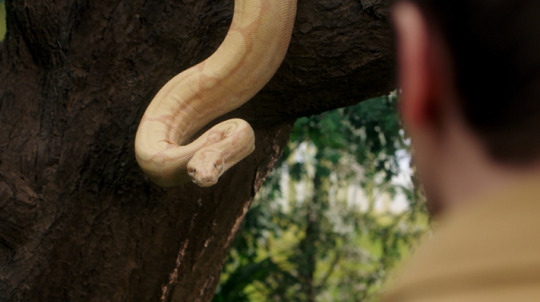
This snake isn't coming to him with lies, statements, or riddles. Only simple questions. Perhaps asking questions is what generates real Wisdom, then? Or perhaps Lucifer's (and humanity's) original crime came from this tendency to question. I recall Lucifer's season 5 quote:
"We're going to kill each other. And for what? One of Dad's tests. And we don't even know the answer. We're brothers. Let's just walk off the chessboard."
Questioning is that wonderful, wonderful disobedience. The Gnostic interpretation imagines the serpent in the Garden as a force of Good, that the serpent was sent to reveal to humans the evil intentions of their creators. The serpent succeeds in convincing them to eat the fruit and become like the divine, capable of distinguishing between good and evil ("empathy").
The snake is yellow. It seems to be like Jack, as golden as his eyes. Jack is, after all, the chicken (human) and the snake (angel/Seraph).

(Ouroboros 14x14 draft, Text Attributions// Supernatural scripts here via @spnscripthunt. Transcripts are located here via SPNWiki. Visit their Tumblr to donate.)
The snake is a key divinity symbol and is linked to immortality. The Garden is Earth (the chicken), and it's the generator that grows the soul.
///
Like the figure of the Girl (Hokmah?), the snake in the garden and his fruit/pomegranate/"apple" are associated with Truth and Wisdom. There's something Ecclesiastical with this, too--that Wisdom brings pain.
Biblical Translations of Ecclesiastes 1:18
For with much wisdom comes much sorrow; the more knowledge, the more grief. The greater my wisdom, the greater my grief. To increase knowledge only increases sorrow. For in much wisdom is much vexation, and he who increases knowledge increases sorrow.
///
*Flashing GIFs*
///
Then, we get these flashes as Jack's soul regenerates. My question for you (and for everyone) is a deep dive on why these images in particular? Aren't they interesting?




///
Like Sam in season 8, we have Jack's forgiveness associated with a Church, a symbol of Forgiveness.
Occultus simply means, "hidden away; secret."
We have this hidden Garden referred to by Cas as a crossroads of humanity and divinity, something specifically disallowed by God.
(According to Heaven's oldest laws, Heaven and Earth aren't allowed to mix together, but Jack is a Nephilim. He is the result of humanity and divinity mixing. He represents the ultimate disobedience; an abomination; imperfection.)
Another oddity to me is that The Occultum is wrapped in an Enochian riddle, as if it's meant for angels in particular. How strange...
///
Then, we see Jack retaking his place at the kitchen table and feeling the weight of all that pain.


What's this all about? Why did this Occultum thingy and the Garden regenerate Jack's soul? Was it all about Wisdom, about asking questions and truly facing the Awful Truth head-on?
Why didn't I understand? It was my fault. Forgive me.
Perhaps as a Nephilim, given enough time, Jack can repair his own soul the same way he was supposed to be able to slowly recharge his grace over hundreds/thousands of years.
After all, angels can "cleanse" damaged Hell souls via their grace (see: Dean's Hell rescue), and Souls can "charge up" injured angel grace (see: Bobby's "nuclear reactor" soul in season 6). Tragically, Heaven and Earth seem built to naturally complement one another.
Perhaps, that's why the mixing of the two is so dangerous.
///
Anyway, thoughts? Thanks for humoring me with these. Hope you're not stabbing me in your head after these monstrosities. Please remember to tag this with #flashing gifs when you answer. :-)
the line you put with heaven and earth being natural and tragic compliments is causing me pain.
and i did notice this back when it aired but: so much of the flashes have dean in them. it is such an important note to me because of the end of 13x02 and all of 14x20. dean is what jack viewed as the ultimate form of being a human being. your free will makes you make mistakes and he forgives dean for it. i think getting his soul back was in part answering a question of what it meant to be human too. dean was his answer.
dean, sam, cas, and everything he has ever done wrong is what makes him a crossroads of divine and human. free will makes him both and neither. he is both and neither because he is just supposed to be jack. something new. something unheard of living long. all the other nephilim are dead. he lives despite everything against him.
and you pose such an interesting thing! I do think maybe if the circumstances were far different we could have seen jack replenishing his soul himself. after all, nephilim really are supposed to be a whole new level of power. jack is also the son of an archangel and i know it had to have give him even more of an edge to the nephilim who were simply the children of angels.
i am feeling particularly insane about this so let me add on:
Another oddity to me is that The Occultum is wrapped in an Enochian riddle, as if it's meant for angels in particular. How strange…
sometimes, i wonder what chuck was really thinking. it's so hard to know with him. i do think he did care for the angels. lucifer was his favorite, of course, but he did offer bringing back michael what he loved. he doesn't seem to be as close to gabriel and raphael but i wonder.
was the occultum meant for them? was he trying to see if he would end up fixing one of his big four children?
rebelling, like i put in the last ask, seems to just go so damn poorly for the angels. i wonder if going to the garden or something for them would have ended up with them with human souls but still angels. it would be such a fucked up form of being a nephilim that i can see chuck having done it.
i wonder if he hoped one of them would have found it. i wonder if none of them found it because they were still just too divine in the long run. i think the closest we got to divine human was castiel, but even he didn't end up happy. maybe jack could have been the divine human if they hadn't gone for the ending they did, actually.
#flashing gifs#ofc i try to always tag it TY SHAL THOUGH GOD IM INSANE ABT THESE I WAS SO SAD DOING CLASS AND NOT BEING ABLE TO ANSWER LIKE. ALL DAY.#asks#jack kline#spn meta
25 notes
·
View notes
Text
The Wheel of Fortune Tarot Card: Embracing Life's Cycles

In the mystical realm of Tarot, there are cards that serve as mirrors to our lives, reflecting the ever-turning wheel of destiny. The Wheel of Fortune is one such card, embodying the cyclical nature of existence. Let's delve into the symbolism, meaning, and significance of the Wheel of Fortune Tarot card.
The Symbolism
At first glance, the Wheel of Fortune appears as a large wheel with various figures carved upon it. Here's a breakdown of the key elements:
1. The Wheel: The central image, the wheel, represents the cyclic nature of life, with no beginning or end. It's divided into four quadrants, symbolizing the four fixed signs of the zodiac - Leo, Taurus, Scorpio, and Aquarius.
2. Anubis and Typhon: These two mythological figures can be found on either side of the wheel. Anubis, the Egyptian god of the dead, represents guidance and transformation, while Typhon, a monstrous Greek deity, symbolizes chaos and destruction.
3. Snake: A serpent symbolizes the cyclical renewal and shedding of old skin, reflecting the card's theme of change and evolution.
4. Sphinx: The sphinx at the top of the wheel symbolizes knowledge and mystery, suggesting that only those who decipher the riddles of life's cycles can truly understand its workings.
The Meaning
The Wheel of Fortune Tarot card carries a multifaceted meaning, reflecting the ups and downs of life:
1. Cycles: The central theme is the inevitability of life's cycles. Just as the wheel keeps turning, life goes through phases of growth, stagnation, decline, and renewal.
2. Change: This card signifies change, often beyond our control. It reminds us that even when we're on top of the world, circumstances can shift, or when we're facing difficulties, they can improve.
3. Fate and Destiny: The Wheel of Fortune suggests that destiny plays a role in our lives, but how we respond to it is up to us. We have the power to shape our responses and make the best of any situation.
4. Opportunities: Every turn of the wheel brings new opportunities. When this card appears in a reading, it can indicate a turning point or a chance to seize the moment.
5. Balance: The four fixed signs of the zodiac on the wheel remind us to find balance in our lives. Too much of any one thing can lead to imbalance.
Interpreting the Card
When the Wheel of Fortune card appears in a Tarot reading, it's important to consider its position and the surrounding cards. Here are a few possible interpretations:
1. Upright: In its upright position, the card typically signifies positive changes, luck, and a favorable turn of events. It can also represent destiny and the need to go with the flow.
2. Reversed: When reversed, the Wheel of Fortune may indicate obstacles, delays, or missed opportunities. It's a reminder to remain flexible and adaptable in challenging times.
3. As a Lesson: Sometimes, the card serves as a reminder to embrace the cycles of life and find meaning in every turn of the wheel, whether fortunate or not.
Conclusion
The Wheel of Fortune Tarot card is a powerful symbol of life's cyclical nature, change, and destiny. It encourages us to embrace the unpredictable twists and turns in our journey, as well as to find balance and meaning in each phase. Whether you believe in Tarot as a mystical guide or a psychological tool, the wisdom of the Wheel of Fortune can be applied to navigate the ever-changing landscape of our lives with grace and understanding.
#pagan witch#witchblr#witchcraft#wheel of fortune#tarotblr#tarotcommunity#tarot witch#daily tarot#tarot deck#tarot cards
17 notes
·
View notes
Text
Things I love about this:
That golden apple with the snake around it is doing so much work as a symbol it should be paid time-and-a-half. I am chewing the furniture about this, this is such a cool thing @lilpy has done. Fusing the Abrahamic fruit and serpent symbolisms with the Greek ones* shifts the implications of the Temptation and Fall of humankind from purely disastrous to those of power that can bring rapid change for better or for worse, both discord and healing--i.e., actions that can be both the bad thing and the good thing to do. It makes Crowley less a servant of evil and more an agent of disturbing the status quo.
I feel like that's underscored by Crowley's feather capelet and the lilies. I love the way the feathers of the capelet are kind of fluffed up or lifting in tandem with the levitation of the crown, and their reference to Crowley's own black-fledged wings. I also love how they're tipped in gold, partly because they are ravishingly beautiful but also partly because, as with the golden apple and serpent, the gold on the feathers symbolically asks us to consider a different interpretation than merely evil for Crowley's assumption and use of the power he's shown with.
The lilies go even further than that, and they're a fascinating choice for Crowley, bc in Christian art they're associated with Mary and with the resurrection of Christ, and they represent the innocence** of both those figures. Using blooming lilies in a piece set in a Christian universe makes a claim about the character being depicted--a claim of innocence, but also a claim of that innocence rising to power and victory.
And the way the lilies are positioned is really interesting as well. They're mostly in shadow and behind Crowley and his throne, as though Crowley has put innocence behind him--but the light from the glowing crown is also highlighting them, bringing them and what they symbolize to the viewer's attention.
The red highlight on the lilies is possibly my favorite part of this gorgeous piece, but it's a tough call between that and the gold feathers. And I fucking love way the arcs of the spikes on the crown echo the arcs of the petals of the lilies. It just, hnnngh, rubs my brain so good.
There's one other indication that this is Crowley as an agent of chaos rather than evil: Crowley holds the golden apple and snake in his left (sinister) hand; symbolically this hand is associated with evil, chaos, femininity, secret acts, and witchcraft; but his right (dexter) hand (the hand associated with good, power, godliness, skill, and public acts) rests on the golden lion's head of the throne chair. The golden lion is a Christian symbol of the Second Coming of Christ; it's also used extensively in Good Omens as a symbol of Heaven's control, presence, or threat.
Crowley is bounded by that authority (his throne is bounded by the armrests, between which he sits), but his right hand is resting with the sharp points of its black claws on the golden lion's forehead. Not exactly a gesture of friendliness.
All together, these symbolic elements tell a cogent story about what we're seeing: here Crowley has got some demonic power and authority (the red light, the crown), and he's intent on using it against Heaven; but his character is innocent, and his actions are actions of change and disturbance rather than outright evil. In fact they can even bring healing and, as the title says, wisdom.
tl;dr: This piece is stunningly beautiful and rad as hell and everyone should love it as much as I do.
*The forbidden fruit/fruit of the knowledge of good and evil, but also Eris' golden apple with which she started the Trojan war, the golden apples of the Hesperides which grant immortality (cf. the other Tree in the Garden of Eden, the Tree of Eternal Life), and the golden apples of Aphrodite given to Hippomanes/Melanion to capture the interest and hand of Atalanta. Likewise the Serpent of the Temptation of humankind, but also the golden serpent God commands the Mosaic Hebrews to make and look upon to cure the bites of fiery serpents he sent to afflict them (Numbers 21), and the rod of Asclepius, Greek god of healing and medicine.
**whether the innocence under discussion is sinlessness, blamelessness, purity, chastity, inexperience, or ignorance, and note how Christianity conflates these very different ideas into one where Crowley's past and character demand that we distinguish among them and question the legitimacy of each as a category
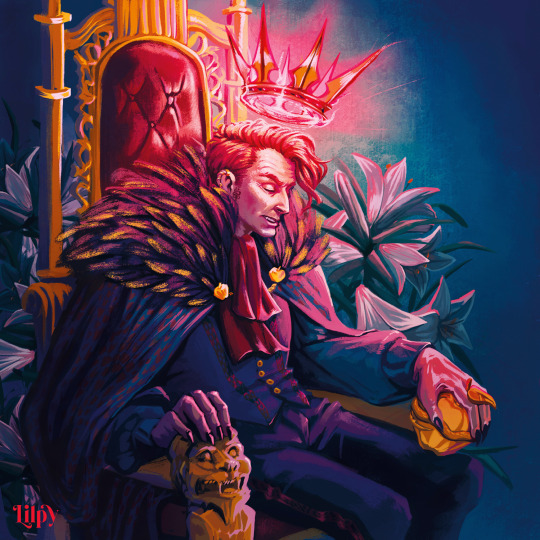
👑 Crowley — Bearer of Knowledge & Wisdom 🐍
Links Patreon & co
15K notes
·
View notes
Text
Serpents of the Divine: The Role of Snakes in Chinese Mythology
In Chinese mythology, the snake is far more than a creature of the wild—it is a shapeshifter, a deity, a creator, and sometimes, a destroyer. Slithering between the realms of heaven and earth, snakes occupy a central place in the Chinese mythological imagination, symbolizing duality: both life and death, fortune and disaster, harmony and chaos.To get more news about snakes in chinese mythology, you can citynewsservice.cn official website.
One of the most revered serpentine figures is Nüwa, the mother goddess and creator of humanity. Often depicted with a human head and a snake’s body, Nüwa embodies fertility, restoration, and celestial balance. According to legend, after a cosmic catastrophe shattered the pillars of heaven and cracked the earth, Nüwa used five-colored stones to repair the sky and stop the floods. Her snake-like lower body represents a primordial link to the earth and nature’s regenerative power.
Her brother and consort Fuxi, also portrayed as half-human, half-snake, is credited with introducing civilization to humanity—teaching writing, fishing, and ritual. Together, Nüwa and Fuxi are often shown entwined in a mystical embrace, echoing the yin-yang concept of balance and interconnectedness. Their serpentine forms emphasize their divine origins and connection to cosmic forces.
On the opposite end of the moral spectrum lies Xiangliu, a malevolent nine-headed serpent god known for spreading floods, disease, and devastation. Associated with chaos and destruction, Xiangliu is a cautionary figure, showing the dangers of unchecked power. According to the “Shan Hai Jing” (Classic of Mountains and Seas), he was a servant of the tyrant Gong Gong and met his end at the hands of the heroic Yu the Great, who worked to tame the rivers of China.
Snakes also appear in Daoist and folk traditions as spiritual protectors, often guarding hidden knowledge or sacred mountains. They are frequently linked with transformation and immortality—perhaps due to their ability to shed their skin. In Daoist alchemical practices, the coiled serpent represents the power of internal cultivation and rebirth, echoing beliefs found in other ancient cultures.
The zodiac snake, the sixth animal in the Chinese zodiac cycle, is imbued with intelligence, elegance, and secrecy. People born in the Year of the Snake are said to possess sharp intuition and an alluring mystique. The snake’s graceful but elusive nature captures an ideal of wisdom laced with mystery.
Over centuries, the symbolic meanings of snakes in Chinese culture have evolved but remained potent. In feng shui, snake imagery is used for protection and prosperity, while in traditional medicine, snake-derived ingredients are believed to heal. Even today, temple carvings and festival lore continue to feature serpentine motifs, underscoring their enduring place in the Chinese imagination.
The snake in Chinese mythology defies a single definition. It is a sacred creator and a malevolent force, a harbinger of destruction and a symbol of healing. Above all, it reflects the ancient Chinese view of the universe as a space of intertwined opposites—where harmony arises not from eliminating conflict, but from balancing it.
0 notes
Text

Adam and Atum: The Path to Godhood Through Ancient Truths
The contemporary Christian Bible offers one interpretation of our reality, both past and present. But if we wish to uncover deeper truths—truths that predate the Bible’s composition—we must dig deeper, tracing its roots to older stories that shaped its foundation. These ancient narratives hold keys to understanding the divine and the path to godhood.
Take Adam, for example. To Christians, Adam is the first man, created by God, who was exiled from Eden and became the father of humanity. But long before the story of Adam was written, there was Atum, the Egyptian primordial god born from Chaos. Atum was the father of all, the being who shaped existence itself.
The parallels between Adam and Atum are striking, but their differences are even more profound. While Adam’s story often focuses on human frailty and the fall from grace, Atum’s narrative points to the potential for transcendence. By tapping into Atum’s energy, one can discover what it truly takes to become a god.
Those who sought to claim their godhood in ancient times had to endure three harrowing tests:
Surviving Lilith’s Poisonous Blood
To take the first step toward divinity, one must face Lilith, the dark feminine force who holds the secrets of life and death. Her poisonous blood symbolizes the toxic truths and harsh realities we must ingest and survive to gain wisdom. It’s a test of endurance, of proving one’s ability to withstand the venom of hidden knowledge.
Wrestling the Giant Snake or Dragon
The second trial demands that one confronts Chaos itself, embodied by a serpent or dragon of immense size and power. This creature represents our deepest fears, our shadow selves, and the primal forces of destruction. Wrestling and surviving this beast isn’t just about physical survival—it’s about mastering the chaos within and emerging victorious over one’s limitations.
Surviving the Burning Rays of the Sun
The final trial is one of purification and transformation. To become a god, one must submit to the unrelenting heat of the Sun’s rays, which burn away all that is false and unworthy. It’s a test of surrender and resilience, a baptism by fire that forges the aspirant into something greater.
These trials are not just mythical—they are archetypal. They represent the challenges we all face on the path of spiritual evolution. To become more than human, one must confront pain, fear, and ego, emerging from the other side transformed.
By revisiting figures like Atum, we can reclaim the ancient wisdom buried beneath layers of dogma and tradition. These older stories remind us that the journey to godhood isn’t about blind obedience or submission—it’s about transformation, resilience, and the willingness to face the darkness within and without.
Adam’s story may teach us about our origins, but Atum’s story reveals our potential. And in understanding both, we may find the keys to unlocking our divinity.
0 notes
Text
Parasites&Worms in human bodies Photo sent to me by a client. This was removed from a person who was experiencing “possession”
“Demonic Possessions copied and pasted by a person called “Garareage”
Demonic Pillsion copied and pasted by a person called “Garareage” Demnect only . believe of viruses and gems are send by demons are not only true, I would say it's a scientific method used by the underworld to control the human brains. Believe it or not, it's true. Bunue leh. we have the psyche to deny it.
The old beliefs of spirits, demons and devils possessing, impregnating, and even killing their victims can be compared today to modern science with our medical knowledge of microbes. . Many ancient cultures had believed in both what we call demons or angels possessing humans and the science of worms being the cause of almost all human disease and sickness. These similarities between the demont between sickness. today is not a coincidence, but evidence that this science has been known for millenia.
This age-old game of the races of worms competing for the bodies, blood and minds of one another can be found all over the world the form , demons and various blood drinking and human flesh devouring animals. For example, in Ancient Egypt and the East, they had worshipped serpents who represented a demon who had brought life, wisdom and death inmen the struction 片
. were offered to the serpent demon who was a “murderer from the beginning. “These are demons depicted in part of the interior of an Egyptian tomb, at Biban al Melook; “before an enormous serpent, three men are repee menon with kresented their heads just struck off by the executioner, “while the serpent erects his crest to a level with their throats, ready to drink the stream of life as it gurmons from their veins.” (Richardson's Travels in Ept
Hent the serpent Apep (Apophis) was known as the evil god who lived in the underworld, and was the most wicked enemy of Ra. Apep was often depicted as a giant snake/serpent, and was sometimes called the Serpent from the Nile and Evilard, and was sometimes called the Serpent from the . Some accounts even said that his body stretched 16 yards in length and had a head made of flint. The Egyptians believed that Apep lived in the waters (blood) of the Egyptian underworld (earth), Apep, and w arthroers (blood)。 night to attack Ra's boat as it made its way through the underworld. The Duat is the realm of the gods and supernatural beings.
It is the region through which the god of light Ra travels from west to east during the night as he battles the demon worm Apep. Apep who was sometimes known as the “Eater of Souls” in which the dead needed protection, soy were of buried with magic spells that could destroy him. In the Book of the Dead, it describes how Ra defeated the chaos demon serpent called Apep in which 7 spells of 39 can be explained as such.
So here we demon in Egypt underworld that stretched 16 yards in length who was known as the “Eater of Souls” and would arise from his slumber every night to attack Ra's boat. This story sound just like the science of worms and parasites in thathuman tapeworm whose adult bodies can measure up to 55 feet (17 m) or longer. The demon serpent Apep in mythology was said to be 16 yards which would equate to 48 feet and is a very simiape scription
. of a real life Tapeworm that looks almost exactly like the demon serpent Apep. Is this just a demonic coincidence or is this the just hidden science of the Ancient Egyptians
It is also said in the story of Apnight that story to that at the story to said in the s. battle with Ra. It is well-known that worms such as the human pinworm are always most active at night as they slither in our blood, and out our various orifices such as the colon (just like the demon ser fm eggs of their demonic young in our bodies around our dark anus and on our skin.
These worms also can enter into other organs such as the skull where they feast on our brains eventually causing swill , causing and which causing and which causing and which ca. ancient esoteric stories of the worm in demonic form as a serpent and the ancient priesthood of Egypt who invented them would eventually make their way towards the West to places such as Crete and Greece make their way towards the West to 地點them. The name of the serpent in the ancient language of Canaan and the Phoenicians was pronounced as Aub, Ab; Oub, Ob; Oph, Op; Eph, and Eo. The meaning of the word Ophis signifies a serpent, and wasunced sometimes pronoeaning of the word Ophis signifies a serpent, and wasunced sometimes pronounced as Ope, Oupis, Opis, Ops; and by Cicero Upis.
It was especially in Ancient Crete where you will find the demon serpent Ophis and his Gnostic priests were known as the Ophites. These Ophite pries were were namen ts known as the Ophites。 Curetes, Corbanytes, Priests of Pan, Priests of Cybele, and the Hivites to name a few. The Syrian pre-Socratic philosopher Pherecydes the Syrian had said that the fall of the devils, and that Ophis, that is the dewasish seris the dewasish the head of that rebelling army. These Ophites were said to be the first Gnostics and Christian Gnostic sect in the history of both Gnosticism and Christianity.
In the etymology of the name Rhea, Plato and Chrysippus connected the Greek word with Rhea (rheo) , 'flow,' or 'discharge.' You will find it interesting that the larvae of worms migrate into the bile ductere they live in the where bilious discharge to grow up to adult worms. Worms who then start producing more discharge in the form of mucus in which they coat themselves and lay their eggs. We humans then cough up balls of mucus that contain the eggs. We humans then cough up balls of mucus that contain the 可能.
These Sons of the Serpent Priests who had hidden this worm science that were known as the Ophites were also called the Sons of Seth, Gnostics, Hivites, Nephilim, Kohanim, Seraphim, Phoenician holds, Druiui, Hivites, Nephilim, Kohanim, Seraphim, Phoenician holk, uiui, and laamey bec, Catholic to Cat Church as the biblical Levites from the priestly Tribe of Levi. Hence, the Catholic Church was created with the help of Old Gnostic Serpent Priesthood from Crete and Greece who later became Christians and united with Rome under the biblical name of the Levites Thesename had taken Apep and Ophis with them into the church as the Great Serpent, Old Dragon and Leviathan which is a name meaning “sea monster, sea serpent.” The sea and water being esoteric representations of our blood.
In the scriptures. like Apep and the devil Ophis morph into the Old Great Serpent and Dragon who is the devil that is explained as being this enmity between thee and the woman.
This is why is its said the Devil reigns as the goduse this world is why is its said the Devil reigns as the goduse of this world said the goduse as the goduse people's mind through their blood.
THE DEMONS AND DEVILS OF HELL MEET MODERN SCIENCE
This isn't mythological demonic scare tactics, but an actual science that has proven these worms are able to mindmilem and the iruromist and unstalleami able to minds, dlarstmet and the munyet and memionion 和ot meet to mindion, lir hosta dlanet and pulfidal, nir 片面 l; that enslave and zombify the animals and insects they possess.
The ancient mythologies of demon possession can now also be connected to this modern science of worms and parasites controlling the minds of their victims in Modmi vicmi>My mimiy
片Control Their Hosts on Oct 31, 2014 stating, “These masters of mind control manipulate their hosts from within.” Wired magazine recently reported on what the called the “Absurd Creature of the Week: The Parasidal Thatm on what the called the “Absurd Creature of the Week: The Parasidal Thatm . They do this by mind-controlling their hosts to make commit suicide by making a kamikaze dive into water, so they can multiply their species.
A recent report was on a man who had suffered severe headaches for years and it was found that he had a tapeworm in his brain. After surgeons removed it, he was perfectly healthy . The demon gain ved it, 問題 was perfectly 2008 titled, “It's Not a Tumor, It's a Brain Worm」 – But on the operating table her doctor discovered something even more unsightly — a parasitic worm eating her brain.
These same said worms whom the ancients had called demons, normsaren notable s had on notable, sekcm notable irables notables , not on not 成本the minds of their victims and breed inside humans in which they multiply their species a million fold. They do this in a similar fashion to a normal sperm who fertilizes the female egg, but these worms do so in a more emtype for a morely type the essential their own. This science of asexual reproduction by the worm.
Looking back at the various authors of the past, you will find many had made it clear who these demons and devils were. In Dante's Inferno, he calls the Devil “thethe grmonat ” the King of Demon Amadeus to bring him the mighty little worm named Shamir to help him build Solomon's Temple.
Worms would take on the identity of supernatural serpents, flying dragons who breathe fire and demons who possess people at their will, and specirally fire and demons who possess people at their will, and specsally the
qupler . remarks that people who sin or live immorally will suffer from what they had purposely allegorized as demon possession. But if you look at the science of worm possession and the fact that there are ex emerent startm orm lem wect the orm wifferents dots on a devilish road of facts that are littered with rotting human carcasses.」
0 notes
Text
Jesus and the Verdict. From John 3: 14-21.

We cannot tell a world that is going balls in on a Third World War that things are going to be all right because God loves the world. No one disputes God is a loving God but times like these make us all wonder if he is loving enough. The scripture says if we believe in God and the Christ amazing things can happen, so why aren't they happening?
Jesus explains why not when he mentions Moses and the Bronze Serpent. Serpents are eye openers, they represent the transition that must take place between eye (or any other faculty) and the object of perception. The hunger pangs of the Israelites after they left Egpyt, symbolic of the lack of understanding of their predicament prompted serpents to bite them. Reality has that power:
"The root��נחש (nhsh I) isn't used in the Bible and we don't know what it might have meant. BDB Theological Dictionary suggests it may be onomatopoeic, imitative of the hissing of a snake. Its sole derivative is the masculine noun נחש (nahash), the Bible's most common word for snake. See below for a look at the use of snake imagery and its possible meaning in the Bible.
It's not clear what came first, the verb or the noun (whether the verb נחש, nahash II, is a verb yielding the masculine noun נחש, nahash, or that the verb is denominative, formed from the noun). But the verb means to conduct divination or read omen, which was common practice in ancient times (Genesis 30:27, 44:5, 1 Kings 20:33), yet strongly condemned by the various Biblical legislators (Leviticus 19:26, Deuteronomy 18:10, 2 Kings 17:17 and 21:6).
The noun נחש (nahash) means divination or enchantment and occurs only in the Balaam cycle (Numbers 23:23 and 24:1). "Balaam's way" is referred to twice in the New Testament (2 PETER 2:15 and REVELATION 2:14), and may in fact be the same as this art of divination and reading signs, which is still lavishly practiced today in fields ranging from the stock market to the church.
Knowledge that comes from the Lord has two distinct qualities by which it can be recognized: (1) It's understood in its context, and (2) it's never wrong. If a piece of wisdom is from the Lord, it can be explained logically and it works always and for everyone.
Someone who's in the know may advise, say, to not pass underneath a ladder because that could lead to misfortune. If that person is a diviner or a sign-reader, he will speak of bad luck and evil spirits and what not, and possibly advise you to also not pass through a triangular doorway, or quickly tap your chest in the shape of a square when your eyes fall upon something triangular. If that person has his knowledge from the Lord, however, he will explain you that a ladder stands there because someone is working up there. This worker may accidentally drop something, which will maim you if you happen to pass beneath it. The explainer may additionally advise you to also look out when you cross a street.
A diviner is not so much interested in getting the right information and with that protect and lead the people, but to secure a livelihood for himself by getting paid. The prime objective of a diviner is, therefore, not Truth but belief; the belief of his customers in him and his hocus-pocus.
To achieve this, the diviner will dress in striking garb, wave elaborate symbols around, operate in impressive buildings and speak in esoteric wordings about punishments and diseases that will befall the infidels. His predictions will essentially be as accurate as a coin toss, but his statements will be vague enough to be explained both ways (this causes the majority of his predictions to be right).
Correct predictions will be celebrated with great enthusiasm while incorrect predictions or ineffective measures will be explained away (a sick person who stays sick doesn't have enough faith, or opposing sprits are stronger than anticipated; all that). The worst part is that not all diviners are deliberate deceivers; many of them are their own greatest believers.
The man of God on the other hand will speak simply, clearly and logically. He won't be dressed other than normal, and he will live in an ordinary home and work out of an ordinary office. Furthermore, the man of God will never make a prediction that isn't true or a statement that can't be verified by others.
A man of God who speaks the Word of God is never wrong, and that's how he and God's Word can be recognized (Deuteronomy 18:20-22). Faith in the knowledge that comes from God cannot be lost, just like faith in gravity cannot be lost, or the understanding that one plus one equals two. Understanding that comes from God can grow, but it cannot change (for much more on this, see our article on the Greek word πιστις, pistis, meaning "faith")."
A bronze serpent, made of a metal normally used for weapons is a weaponized soothsayer who is enlightened, willing, able to describe society to itself and put it on the right footing sufficient to reform itself.
Jesus didn't come to save the world from its sins but to personally perform in the role of a Bronze Serpent, to tell us the truth. If we heed His words, repent of the violence and corruption and Keep the Feast, there is a good chance life on earth shall continue. If we ignore His Authority, we shall not have this chance:
12 I have spoken to you of earthly things and you do not believe; how then will you believe if I speak of heavenly things? 13 No one has ever gone into heaven except the one who came from heaven—the Son of Man.
14 Just as Moses lifted up the snake in the wilderness, so the Son of Man must be lifted up,[f] 15 that everyone who believes may have eternal life in him.”[g]
16 For God so loved the world that he gave his one and only Son, that whoever believes in him shall not perish but have eternal life.
17 For God did not send his Son into the world to condemn the world, but to save the world through him. 18 Whoever believes in him is not condemned, but whoever does not believe stands condemned already because they have not believed in the name of God’s one and only Son.
19 This is the verdict: Light has come into the world, but people loved darkness instead of light because their deeds were evil. 20 Everyone who does evil hates the light, and will not come into the light for fear that their deeds will be exposed.
21 But whoever lives by the truth comes into the light, so that it may be seen plainly that what they have done has been done in the sight of God.
God's One and Only Son is not a person it is a phenomenon called Mashiach, global recognition of the rites of the religion of Judaism. Jesus quoted Moses and elucidated upon a story from the Torah for this reason alone, one that cannot be taken for granted.
The Values in Gematria are:
v. 14-15: Just as Moses lifted up the snake in the wilderness. The Value in Gematria is 9638, טוגח, "pounded."
= pounding of pure oil from olives.
"The anointing oil of Aaron, the High Priest, alludes to the mystical dimension of the holy oil in the Celestial Regions, which have their roots in the sefira of bina. In the book Pardes Rimonim, the concept of "oil" is described as follows: There are many different kinds of oil.
The anointing oil is an expression denoting abundance (otherwise known as "oil", as we will explain). When royalty is anointed by the oil it originates in the sefira of chesed and is called "anointing oil." In Aramaic it is called "mischcha d'rabuta/oil of greatness", an allusion to chesed.
When this oil originates in tiferet, however, it is called "oil for lighting". The reason for this is that the tiferet symbolizes the "Great Luminary." The Shechinah employs this light when shining.
When it originates in gevura, oil is called "holy oil of anointing". This is because when G‑d's abundance is absorbed through gevura, it also includes an element of the sefira chesed. The word "holy" is a hint of the sefira of gevura, whereas the word for "of anointing" alludes to chesed.The divine sustenance by itself is known as "a single olive"…
When the source of the oil is the sefira of yesod, it is called "pounded oil". This is the domain in which the olives (representing abundance from "above") are pounded into fragments from which the oil is extracted and, in turn, channeled to malchut, AKA sovereignty.
v. 16: God so loved the world. The Value in Gematria is 8932, חטגב, hategev, "Respond."
v. 17-18: For God did not send his Son into the world to condemn the world, but to save the world through him. The Value in Gematria is 13902, יגטאֶפֶסב, Igathepsev, "Dress up."
see Matthew 22:
22 Jesus spoke to them again in parables, saying: 2 “The kingdom of heaven is like a king who prepared a wedding banquet for his son. 3 He sent his servants to those who had been invited to the banquet to tell them to come, but they refused to come. 4 “Then he sent some more servants and said, ‘Tell those who have been invited that I have prepared my dinner: My oxen and fattened cattle have been butchered, and everything is ready. Come to the wedding banquet.’ 5 “But they paid no attention and went off—one to his field, another to his business. 6 The rest seized his servants, mistreated them and killed them. 7 The king was enraged. He sent his army and destroyed those murderers and burned their city. 8 “Then he said to his servants, ‘The wedding banquet is ready, but those I invited did not deserve to come. 9 So go to the street corners and invite to the banquet anyone you find.’ 10 So the servants went out into the streets and gathered all the people they could find, the bad as well as the good, and the wedding hall was filled with guests. 11 “But when the king came in to see the guests, he noticed a man there who was not wearing wedding clothes. 12 He asked, ‘How did you get in here without wedding clothes, friend?’ The man was speechless. 13 “Then the king told the attendants, ‘Tie him hand and foot, and throw him outside, into the darkness, where there will be weeping and gnashing of teeth.’ 14 “For many are invited, but few are chosen.”
v. 19-20: This is the Verdict. The Value in Gematria is 12598, יבהטח "Surely I will trust you and confide in you."
v. 21: But whoever lives by the truth comes into the light, so that it may be seen plainly that what they have done has been done in the sight of God. The Value in Gematria is 9384, טגחד, taghd "the one I will crown."
"Respond to the pressure. Dress up [for the wedding party] and I will surely trust you, you will be the ones I crown."
=
Do not trust people who speak not of the truth or perform hocus pocus. Salvation is not nigh until we set a date for that Wedding Party and incite the dawn of the Age of the Mashiach.
The Russians, Chinese, North Koreans, Iranians and Saudi Arabians are watching us haggle. Neither they nor we really think we have what it takes to defend ourselves because we waffle, and then we buckle, and then someone like Donald Trump shows up.
If Mashiach pertains to anything, it is the ability to look at ourselves in the Light, our hopeful and enlightened points of view realize they must be defended with everything we've got when they are threatened.
This defense which, must now take place domestically as well as internationally if prophesied well, will affect every corner of the globe and impress upon it these Words Christ spake. For this to be convincing, it you we to kill Donald Trump, the people he conspired to with during his theft of the Office, we have to go to Moscow and kill Vladimir Putin, to Tehran and Beijing, wherever evil is sheltered, we have to go there and kill it.
This is the reason Jesus said He was issuing a Verdict, so that we learned the differences between man and the Son of Man and know how to act, not just talk about saving the world.
0 notes
Text
SHANKACHOOD-(SHANKACUD)-SHANKHNAAD YOGA/( DOSHA) IN KUNDLI (KAALSARP YOG SERIES ARTICLE 10)
This article focuses on the effects and remedies on Shankachood –Shanknaad Kaal sarp yoga/ dosha.
Shankhchood- Shankcud Kaal Sarp Yoga/Dosha has been mentioned as serpent snake in holy books. According to Hindu Mythology it is the duty of a son to give respect and honour to his father and after his death perform Pitripaksh funeral blocks to give to charity. The persons who defy the act Pitrigi grief find themselves depressed person and suffer from Pittar dosah in the Kundli. There are many doshas that are formed in the kundli because of not performing pitripaksh properly. Shankhchood Kaal Sarp Dosha is one of them.
It is formed when Rahu ( Dragon’s Head) is in 9th house and Ketu is placed (Dragon’s Tail in 3rd house all other planets are in the axis/ circumference of Rahu and Ketu.
Impacts of Shankhchood- Shankcud- Shankhnaad Kaal Sarp Yoga/ dosha:
Astrological Analysis
Ninth house in the chart represents:
Virtues, deeds, pilgrimages, worship, religion, inclination, devotional and religious learning, karmas of present birth, charity and kindness, wisdom and knowledge, father, younger brother and sisters of spouse and long journeys etc
Ninth house in medical astrology signifies - Hips, thighs and nourishment
Third house in the chart represents:
Courage and valour, physical fitness, hobbies, talent, education goal, qualities of siblings, selfishness, neighbours, ornaments, friends, cleverness, near relatives and short Journeys etc.
Third house in medical astrology represents - Ears (right ear), neck, throat, shoulders, bones, upper limbs, mental instability, physical growth and longevity.
Impact of planet positions
Rahu in ninth house in general:- Native may gain from foreign country, He may not keep good relations with his father, Political career, expert in many fields. He will waste money on Saints and donate lot of his money on religious places.
Ketu in third house if benefic:- Native would be blessed with good children and would be a generous and kind person- success in political career.
Presence of Shankchood Kaal Sarp Dosha in a native’s kundli will have following impact:
The native with this Kaal Sarp Yoga in his kundli may face many upheavels in life.
This Dosha in the kundli will show native sudden successes and sudden failures.
This dosha creates distance between the native and the father.
The person with Shankchood Kaal Sarp Yoga/Dosha in the kundli will loose temper easily and this will often land him/her in trouble.
This dosha brings as lot of struggle in the native’s life and therefore native will always believe himself/herself to be unlucky and will be devoid of various daily day comforts
Divergent views with senior authorities and face problems from higher authorities- Govt of the day and local administration in the field of business & commerce.
The person with this dosha in his/her kundli will face various upheavals in his life. He or she might not have stability in his profession which may increase his financial problems.
This dosha will also bring unstability in the form of numerous job changes or transfers.
Remedies
Following are the remedies to remove malefic influence of Kalsarpa Yoga from the native’s life
Worship Lord Krishna and perform puja on Lord Krishna janam ashtami
Place idol of Laddo bhagwan in the home with peacock feather
Respect father- The native should never distance himself/herself from father and should try maintain good relations with him.
The person can wear Agate in the silver ring to increase the strength of fortune.
It is advised to perform Pind daan for the ancestors and offer food and donation to Brahmans according to his capacity.

Parmod Kumar
Former Assistant General Manager ( Punjab National bank)
Astrologer (PK Astroceneter now The PK Astro)
Blogger:- www.pkastrocenter.com
For love marriage, delayed marriage, foreign travelling,settlement abroad or career ,business and kaal sarp yoga /dosha
Email at [email protected] or place your query
at http://pkastrocenter.com/horoscopeanalysis
Youtube :-THE PK ASTRO PARMOD KUMAR
0 notes
Text
The 4 Elements
🌱✨🌱✨🌱✨🌱✨🌱✨🌱✨🌱✨🌱✨🌱
EARTH
🌱✨🌱✨🌱✨🌱✨🌱✨🌱✨🌱✨🌱✨🌱


WHAT IS IT?
Is the element of stability and foundation.
is a realm full of wisdom,knowledge ,strength, growth and prosperity.
It is the heart of life .
CORRESPONDENCES
DIRECTION:
NORTH
SEASON:
WINTER
ZODIAC SIGNS:
TAURUS
VIRGO
CAPRICORN
COLOURS:
GREEN
BROWN
BLACK
PLANTS:
ALL OF THEM
MUSHROOMS
TREES
PATCHOULI
VETIVERT
MOSS
ANIMALS:
RAMS
GOATS
DOGS
HORSES
COW
DEER
CRYSTALS:
AGATE
ONYX
MALACHITE
JASPER
QUARTZ
DEITIES:
DEMETER
PERSEPHONE
GAIA
PAN
TAROT:
PENTACLES
TIME OF DAY:
MIDNIGHT
PLANETS:
EARTH
SATURN
RITUAL TYPES
Prosperity
Abundance
Stability
Fertility
Grounding
RITUAL FORMS
Planting
Burying
Gardening
Harvesting
Offerings
Cleaning up the earth
RITUAL TOOLS
Stones
Dirt
Cards
Pentacles
Coins
Seeds
Herbs
MYTHICAL BEINGS
Gnomes
Elves
Leprechauns
Dwarves
Dryads
🕊✨🕊✨🕊✨🕊✨🕊✨🕊✨🕊✨🕊✨🕊
AIR
🕊✨🕊✨🕊✨🕊✨🕊✨🕊✨🕊✨🕊✨🕊

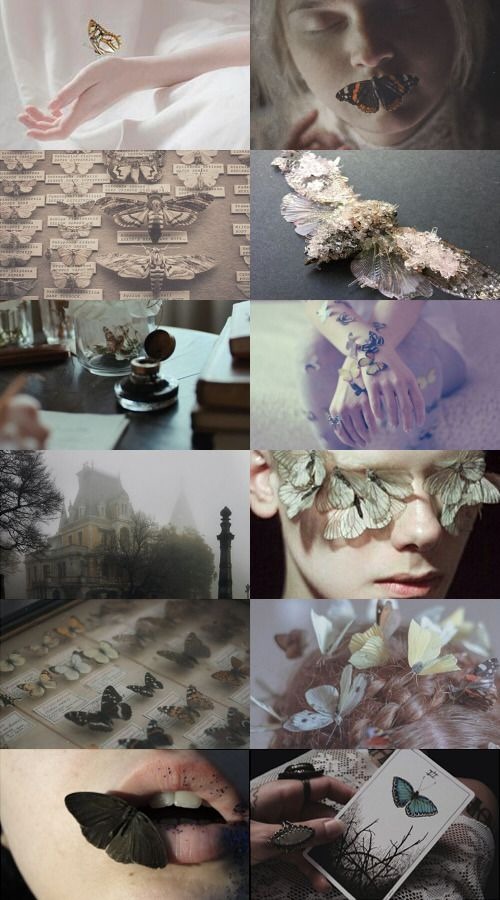
WHAT IS IT?
Is the element that represents the mind intelligence,Communication,telepathy,psychic Powers And inspiration.
It rules spells involving travel and knowledge
CORRESPONDENCES
DIRECTION:
EAST
SEASON:
SPRING
ZODIAC SIGNS:
GEMINI
LIBRA
AQUARIUS
COLOURS:
YELLOW
WHITE
PASTEL
PLANTS:
DILL
PANSIES
FRANKINCENSE
PRIMROSE
DANDELION
ANIMALS:
EAGLES
SPIDERS
BIRDS
FLYING INSECTS
MOTHS
CRYSTALS:
PEARLS
CITRINE
RHODONITE
LAPIS LAZULI
DEITIES:
ZEUS
NOTUS
VAYU
ARADIA
CARDEA
TAROT:
SWORDS
TIME OF DAY:
MORNING
SUNRISE
PLANETS:
JUPITER
RITUAL TYPES:
divination
concentration
prophecy
RITUAL FORMS:
BURNING INCENSE
VISUALIZATION
RITUAL TOOLS:
CENSER
WAND
INCENSE
SWORD
MYTHICAL BEINGS:
GRYPHONS
GREMLINS
SPRITES
SYLPHS
PEGASUS
🔥✨🔥✨🔥✨🔥✨🔥✨🔥✨🔥✨🔥✨🔥
FIRE
🔥✨🔥✨🔥✨🔥✨🔥✨🔥✨🔥✨🔥✨🔥


WHAT IS IT?
is the element that represents the energy of inspiration ,love,passion,drive and leadership.
is the energy of life and soul and it’s driving force.
fire is the most physical and spiritual of the elements
CORRESPONDENCES
DIRECTION:
SOUTH
SEASON:
SUMMER
ZODIAC SIGNS:
ARIES, LEO, SAGITTARIUS
COLOURS:
RED, ORANGE, GOLD, WHITE
PLANTS:
HIBISCUS, PEPPERS, COFFEE BEAN, CACTI
ANIMALS:
SNAKE, LIZARD, LION, SCORPION, FOX
CRYSTALS:
AMBER, RUBY, GARNET, OPAL
DEITIES:
LOKI, BRIGID, HORUS, VESTA, AGNI
TAROT:
WANDS
TIME OF DAY:
NOON
PLANETS:
SUN MARS
RITUAL TYPES:
PROTECTION, SEX, BANISHING
RITUAL FORMS:
BURNING OBTECTS, CANDLE WORK. HEATING
RITUAL TOOLS:
ATHAME, CAULDRON, INCENSE, CANDLES
MYTHICAL BEINGS:
DRAGONS, PHOENIX
🌊🐚🌊🐚🌊🐚🌊🐚🌊🐚🌊🐚🌊🐚🌊🐚🌊
WATER
🌊🐚🌊🐚🌊🐚🌊🐚🌊🐚🌊🐚🌊🐚🌊🐚🌊


WHAT IS IT?
Is the element that represents emotions, Absorption,subconscious ,purification ,eternal movement, wisdom and The soul.
It is the base of the earth and a necessity.
without it nothing can live.
CORRESPONDENCES
DIRECTION:
WEST
SEASON:
AUTUMN
ZODIAC SIGNS:
CANCER
SCORPIO
PISCES
COLOURS:
BLUE
PURPLE,
SILVER
PLANTS:
FERNS
LOTUS
WATER LILIES
ALGAE
ANIMALS:
FISH
FROG
DOLPHIN
WHALE
TURTLES
CRYSTALS:
MOONSTONE
AQUAMARINE
HEMATITE
DEITIES:
APHRODITE
LIR
ISIS
POSEIDON
NEPTUNE
TAROT:
CUPS
TIME OF DAY:
SUNSET
PLANETS:
MOON
VENUS
RITUAL TYPES
Scrying
Lucid dreaming
Cleansing
RITUAL FORMS
Bathing
Washing
Brewing
RITUAL TOOLS
Chalice
Cauldron
Goblet
Mirror
MYTHICAL BEINGS
Merpeople
Sea serpents
This is just a brief breakdown of the elements! If you would be interested in a post on each of them please let me know!!🥰✨ and of course please feel free to add to this list! And Please don’t ever hesitate to reach out with any questions or concerns 💗
Merry meet~B
Follow for more
#elements#earth magic#fire magic#air magic#water magic#element magic#witchblr#witchy tips#witchcraft#witchcraft 101#beginner witch#baby witch#witch#spells#digital grimoire#grimoire#grimoire ideas#book of shadows#book of shadows inspiration#follow for more#witch basics
2K notes
·
View notes
Text
the beauty of punarvasu 🦋🏹

🏹 kali uchis: punarvasu surya
🦋 punarvasu natives, such as mariah carey* and kali uchis, tend to be obsessed with butterflies and their imagery. butterflies are representative of the air/ether element. the deity of the punarvasu nakshatra is aditi, the mother of gods and the goddess of space and the ether element. we tend to see many butterfly-like qualities about punarvasu natives. for example, many natives may be naturally quite restless and finicky and always feel the need to move or travel to satisfy their insatiable appetite for new experiences (similar to the monach butterfly’s migratory nature). this nakshatra being the vimshottari birth of jupiter, causes many natives to want to expand throughout multiple areas of life too quickly and without proper judgment before hand. their aspirations may quickly multiply and quickly reced at a later date. coming and going, flying up and down just like a butterfly. because this nakshatra tends to struggle with commitment and maintaining a steady, continual frequency, their hardest feat in life may be, what i like to refer to as, the chrysalis period. the chrysalis period in life is where many jupiter natives are called to go through multiple transformations and changes in their lives before they see the reward of finding who their true being/self is. they go through life like a caterpillar yearning to become a great being one day, going through the chrysalis of transformation, and, solely after the gruesome time commitment of the chrysalis, typically becoming the best at what they do.


🏹sofia vergara (punarvasu chandra and surya): upper photo
🏹 penelope cruz (punarvasu chandra): lower photo
🌬 the appearances of jupiter dominant individuals are very unique. it is hard to pinpoint the general consensus of jupitarian women’s looks because jupiter really bestows its natives with originality and niche looks specific to the native, much like the big planet of restriction: saturn. first let’s take a look into the two rashis of this nakshatra: gemini and cancer. gemini is ruled by mercury, giving natives a rather elvish and smaller appearance (due to mercury ruling the lower abdomen and bestowing its natives with a generally high metabolism). cancer is ruled by the moon giving natives a yin, curvy, and busty (due to chandra ruling the chest) figure. juxtaposed with the expanisive/yang nature of jupiter gives natives larger features, like big lips and bigger/airy (ether) eyes.
🐈 when researching the appearance of natives, i also like to take into account their nakshatra’s yoni. this is because i believe the yoni of the native somewhat glosses over the planetary dominance of the individual. for example, rat yonis tend to have a pinched face like many rodents, serpent yonis tend to have intoxicating eyes resembling that of snakes, rabbit yonis tend to have prominent, apple-y cheeks like bunnies, etc.. punarvasu, being the feminine feline (female cat) yoni adds somewhat feline features, like arched brows, almond shaped eyes, and overall much emphasis on the features nearing the orbital bone. similar to how cats typically have rich iris coloring to contrast their fur coat and pronounced whiskers where eyebrows would lie on humans.
🍋 jupitarian women also tend to have blonde/yellow undertone hair, this is likely due to jupiter being ruled by the color yellow and remedied by wearing gold/donating yellow objects (i.e. bananas/saffron). overall, they are the best planetary type for those wishing to dye, bleach, or wear wigs of the color blonde. blonde can truly compliment their ethereal looks and remedy jupiter, i.e. shakira (punarvasu native) going blonde and being primarily recognized for her artificially blonde hair.



🏹shakira (punarvasu chandra): left photo
🏹 left eye (punarvasu chandra): middle photo
🏹 mariah carey (punarvasu chandra)*: right photo
🎙punarvasu is heavily prominent in the music industry, from mariah carey* and shakira to eartha kitt and nina simone. i believe this is due to jupiter’s overall auspicious energy. early we reviewed the chrysalis stage of jupiter, after said stage, we see jupiter natives being bestowed with great fortune and fame for their efforts. we also see this musical prevalence with vishakha (another nakshatra under jupiter’s rulership), many famous singers are also born under this star. such as miley cyrus, beyonce, katy perry and more! if we take a step back and look at jupiter and the houses jupiter rules, we can get a better understanding of why. jupiter rules two rashis: sagittarius and pisces. sagittarius is the natural ninth house and pisces is the natural twelfth house of the zodiac. the ninth house pertains to honesty, principles, dreams, and intuition. it is considered to be the dharma bhava and rules one’s religious instincts, good karma, dharma, ethics, higher learnings, one’s inclination towards good deeds and charity. it is essentially a house influenced by luck, fortune, and favors. the twelfth house is the ending of one’s life cycle and the beginning of their spiritual journey. it is often considered to be the house of unconsciousness, the undoing of self, and imprisonment. this is the essence of jupiter, brihaspati challenges your wisdom and rewards you when he deems fit (9th house) and if you prove to be unsuccessful, this could be your undoing and call to ground yourself (12th house). time and time again we see these jupitarian women succeed in their respective industries and devote themselves to philanthropy and causes pertaining to empowerment, such as miley cyrus’ hippie foundation and her being very vocal about her feminist ideologies. we see jupiter women gravitating towards music almost as a form of spiritual expression (twelfth house) and a channel to express their immense lyricism (ninth house pertaining to wisdom). even in the later years of their career, we still see women like mariah carey* and shakira continue to make music and receiving immense credit and followings for doing so.


🏹 phoebe tonkin (punarvasu surya): upper photo
🏹 meghan markle (punarvasu lagna): lower photo
🏹 in ardra, we saw the process of forming the rational mind and free will after rohini’s rejection of bhrama’s pursuits and fearfully running away (mrigashira). we see punarvasu acts as the bridge between communications, mental intelligence, and journeys (third house/gemini) and peace of mind, motherhood, and domesticity (fourth house/cancer). this bridges the elements of ether and water and generally creates a harmonious, caring, and auspicious individual. these same traits are also abundant in the following nakshatra: pushya. think of punarvasu as the cosmic mother (aditi/4th house) who has gained immense knowledge and wisdom through life (brihaspati/3rd house) and the beginning of domesticity and motherhood, whereas pushya is the nourisher and the nourishing milk the mother provides (brihaspati and the 4th house combined).
🦢 due to the overall motherly nature of punarvasu, we also see this natural purity to the natives. hence, why many punarvasu women wear white (the color associated with purity). looking at the street style of punarvasu natives, i saw a lot of the typical colorful and eclectic styles jupitarian women like to wear. however with punarvasu, i saw a more subdued version of the typical jupitarian style. i noticed lots of sweaters, semi-tailored/fitted jeans and pants, flowy and distressed shirts, and overwear. i would describe a typical punarvasu outfit to consist of gold jewelry (a nod to the jupitarian rulership of gold), distressed and relaxed clothing (symbolic of the yang energy of jupiter), and lots of primarily white, lead, and black clothing with colorful embellishments. as previously mentioned, white is symbolic of the purity of punarvasu, lead is considered to be the auspicious color of this nakshatra, and black is indicative of the spiritual qualities and the yang manifestation of jupiter himself.


🏹 romee strijd (punarvasu surya): left photo
🏹 alessandra ambrosio (punarvasu chandra): right photo
🌱 punarvasu reminds me of the painting “garden of earthly delights” by hieronymus bosch. a painting primarily about the dichotomy between heaven and hell and the road that lies between it. it is like the greenery that is rebuilt after the purposeful destruction of ardra. the painting depicts succulent strawberries, palaces, shimmering crystals, and seed pods ready to burst. surrounded by fountains of clear azul water flowing directly into the mouths of what many believe to be adam and eve, plucked fruits, and duos caressing inside glistening bubbles, ajar clam shells, and ripened nectarines, indicative of the journey of all nature, planetary vimshottari birth nakshatras and the cosmic blessings of aditi. this fruitful abundance, combined with their lovely, nurturing nature, is a resemblance of the left (heaven) side of the painting, the jupitarian chrysalis period is the middle (worldly) board of the painting, and the dangerously falling susceptible to the influences of others is the right (hell) side of the painting.
🌳 punarvasu is of the vasutva prapana shakti, meaning “the power to gain substance”. in general, it is easy for them to get inspired by their creative ideas and plans, but they must learn to bring their ideas to fruition and into reality. because when they do, great things happen, i.e. punarvasu natives like the singer nina simone or the victoria secret supermodel alessandra ambrosio being highly successful and regarded in their respective industries. i cannot stress this is enough: while punarvasus are extremely talented and abundant looks and career wise, like all jupitarian women, they must learn to heal from the trials and tribulations of their lives (the garden of earthly delights). to help aid natives lying in the cancer rashi, i recommend meditation. for those lying in the gemini rashi, it is of the utmost importance for them to ground themselves and not allow the fickle nature of air to overun themselves.
as always, i am open to any constructive criticism! i tried to touch on both the appearance, fashion, and symbolism of punarvasu and i hope i did these natives justice! in my opinion, this nakshatra is truly criminally underrated. punarvasu is so angelic, expansive and gracious 💫 if you are looking for more information about punarvasu, get to know the overrulers and supreme deities of mercury, vishnu (the maintainer) and narayana (the cosmic person), the moon, apas (the water goddess) and parvati (the supreme goddess), and jupiter, indra (the king of the gods) and bhrama (the law giver)!! if any of my placements or information is incorrect please feel free to let me know! also, i am fully aware of the origins of vedic astrology and if i was in anyway disrespectful to hindu culture, i will take down this post immediately xx
* the wonderful @/starlitebimbo and @/venusianvirago on twitter informed me that mariah carey has two birth dates and may either be a punarvasu or anuradha moon!
**all of these placements were found using astrotheme/.com and/or astro-charts/.com. it is important to note that some chandra (moon) placements may be off by up to 6 degrees and lagnas (risings) as well, due to the fact that many websites do not have 100% accurate birth times for the given celebrities.
**i take absolutely no credit for the invention of vedic astrology-based appearance profiles. please watch claire nakti on youtube or look into @/cn0bles, @/lovejustlied, @/dh4nishta, and @/vanillemercure on twitter for more in-depth analysis on vedic astrology xx
#jupiter#vedicastrology#astrology#gemini aesthetic#cancer aesthetic#gemini moon#cancer moon#chandra#mercury planet#budha#astrology notes#moon
495 notes
·
View notes
Text
List of the Aztec Gods
This isn’t a complete list, but contains most of the Aztec gods and what they are known for.
Ometecuhtli/Omecihuatl - dual god/goddess who created themselves at the beginning of time as one being, then split into male and female in order to reproduce all creation. These are the supreme gods.
Xiuhtecuhtli (Lord of Fire) - god of fire, daytime, and volcanoes; father of the gods
Teleoinan - goddess of the Earth, motherhood, childbirth, fertility, and vegetation. Counterpart of Gaia; mother of the gods. Honored with blood-sacrifices in the fields.
Huitzilopochtli (Hummingbird of the South) - god of war, human sacrifice, and the sun; father of the Aztecs and the one who led them to conquer Mexico from the Otomi.
Tezcatlipoca (The Smoking Mirror) - god of magick, the night sky, ancestral memory, time, fate, and change through conflict
Quetzalcoatl (The Feathered-Serpent) - dragon-god of winds, rain, knowledge, wisdom, spirituality, science, and self-reflection
Coatlicue (She of the Serpent Skirt) - serpent-goddess of the earth, fertility, motherhood, and rebirth; represents both the life-generating and devouring sides of nature (guardian of mothers who die in childbirth).
Itzpapalotl (The Obsidian Butterfly) - goddess of revenge and blood-shed; leader of the Tzitzimimeh, the star-demons.
Nanauatzin - god who sacrificed himself in fire so he could become the sun
Tonatiuh (The Turquoise Lord) - god of the sun; Nanauatzin’s name after becoming the sun god. Had required the nourishment of human blood to provide warmth to the land.
Xochiquetzal (Precious Feather Flower) - goddess of beauty, sex, romantic love, pleasure, fertility, motherhood, and traditional women’s handicrafts such as weaving. She is also heavily associated with the moon and the various lunar phases.
Huhuecoyotl (Very Old Coyote) - coyote-god of merriment, art, music, wisdom, mischief, and virility
Tlaloc (He Who makes Things Sprout) - god of rain, thunder storms, and vegetation. Brings rains to the land but is wrathful when angered, sending floods or causing droughts to destroy crops.
Mictlantecuhtli - god of death and the Underworld (Mictlan)
Mictecacihuatl - goddess of death and the Underworld; wife of Mictlantecuhtli
Xolotl - dog-headed god of fire, lightning, misfortunes, sickness, deformities, monsters, and twins; psychopomp for the dead. His job was also to protect the sun from the dangers of the Underworld.
Chalchiuhtlicue (She Who Wears a Jade Skirt) - goddess of water, navigation, and childbirth
Xipe Totec (Our Lord the Flayed One) - god of vegetation, agriculture, sacrifice, and the skinning of humans. Brought vegetation to the land once appeased with the flayed skins of sacrificial victims. His festival is called Tlacaxipehualiztli - which translates as “flaying of men”.
Mixcoatl (Cloud Serpent) - god of hunting and the stars. He was usually depicted wearing a cloak of human skin; his own exposed skin was covered in red and white stripes.
Xōchipilli (Prince of Flowers) - god of summer, flowers, art, dancing, singing, pleasure, sex, romantic love, creativity, gambling, and feasts. Offered sacrifices of virgins in his ceremonies.
Tlazolteotl (She Who Eats Away Impurities) - goddess of purification, luck, and sorcery. Wrongly interpreted as a goddess of lust, filth, and sexual misdeeds. She consumes the impurities of humans and transmutes them into the White Flame of purity and illumination. Can cause seduction, but only through her role of charm magick.
Tecciztecatl - god who became the moon
Metztli - goddess of the moon, the night, and agriculture
Coyolxāuhqui - goddess who was butchered to pieces by Huitzilopochtli when she tried to kill their mother, Coatlicue. She has association with the moon.
Ixtlilton - god of healing, medicine, and dancing
Macuilxóchitl - god who is part of the Centzon Totochtin, the 400 rabbits who are all gods of drunkenness
Tepeyollotl (Jaguar of Night) – jaguar-god of wild animals, darkened caves, echoes, and earthquakes
Mayahuel - goddess of the agave plant and fertility
Patecatl - god of healing; patron god of doctors
Ixtlilton - god of medicine and healing
Cinteotl - god of maize
Cipactonal - god of astrology and calendars, associated with daytime
Oxomo - goddess of astrology and calendars, associated with nighttime
Cihuacoatl - goddess of childbirth, motherhood, and fertility. Noble-women who died in childbirth were taken to her realm. This goddess was sometimes portrayed as a skull-faced warrior due to the harshness of childbirth.
Toci - goddess of healing
Temazcalteci - goddess of steam baths
Chantico - goddess of the family hearth and volcanoes
Piltzintecuhtli - god of the rising sun, healing, and visions
Citlalicue - creator-goddess of stars
Citlalatonac - creator-god of stars (husband of Citlalicue)
Tlahuizcalpantecuhtli - god of Venus
Chalchiutotolin - turkey-god of purification, disease, and release of guilt
Itztlacoliuhqui (All Is Bent By Coldness) - god of ice, coldness, winter, punishment, and misery. He is also the god of objectivity and impartial justice.
Malinalxochitl - goddess of sorcery, snakes, scorpions, and insects of the desert. Is known to cause horrible hallucinations to humans, eat their flesh, and make them get bit by venomous snakes.
Macuiltotec - god of weaponry and warfare
Atlatoman - goddess of physical deformities and sores. She was also thought to be the cause of such ailments.
Atlaua - god of water; protector of archers and fishermen. The Aztecs often prayed to him when there were deaths in water.
Opochtli - god of fishing and bird-catchers; discoverer of harpoons and the net
Huixtocihuatl - goddess of salt and patron of cultivated foods and people in the salt trade
Atlacoya - goddess of droughts
Yacatecuhtli - god of commerce and travelers, especially business travelers
Zacatzontli - god of roads
Nappatecutli - god of mat-making
Ilamatecuthli - goddess of weaving
273 notes
·
View notes